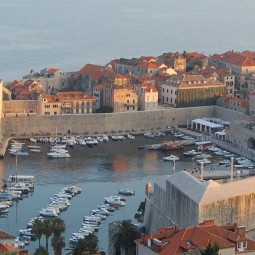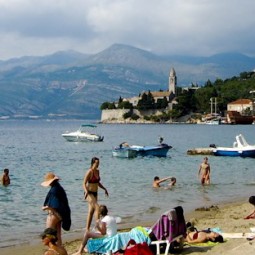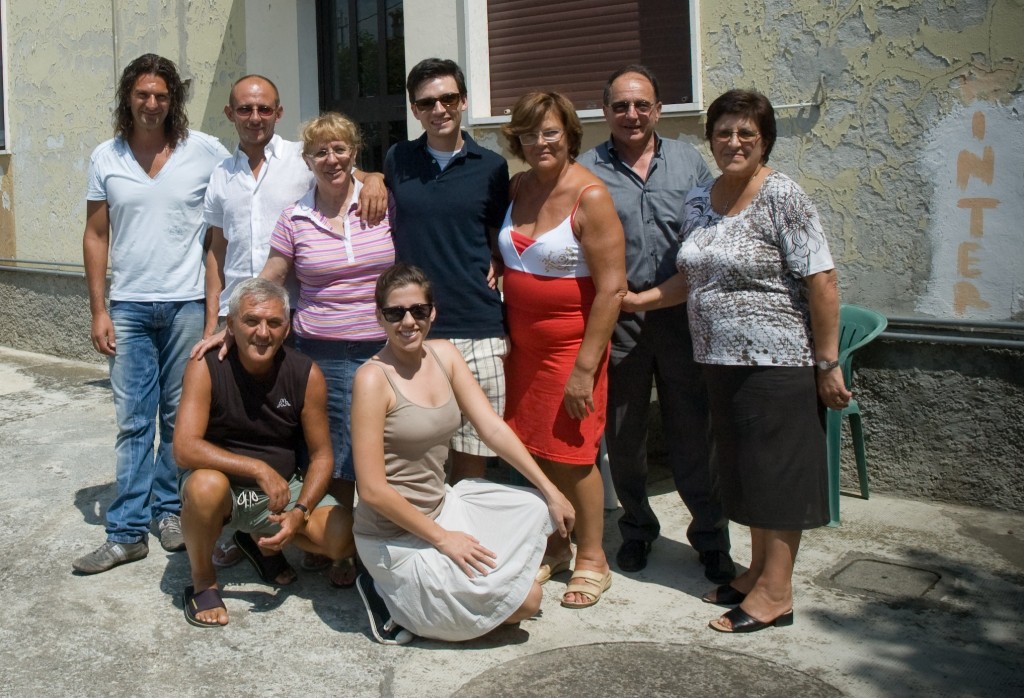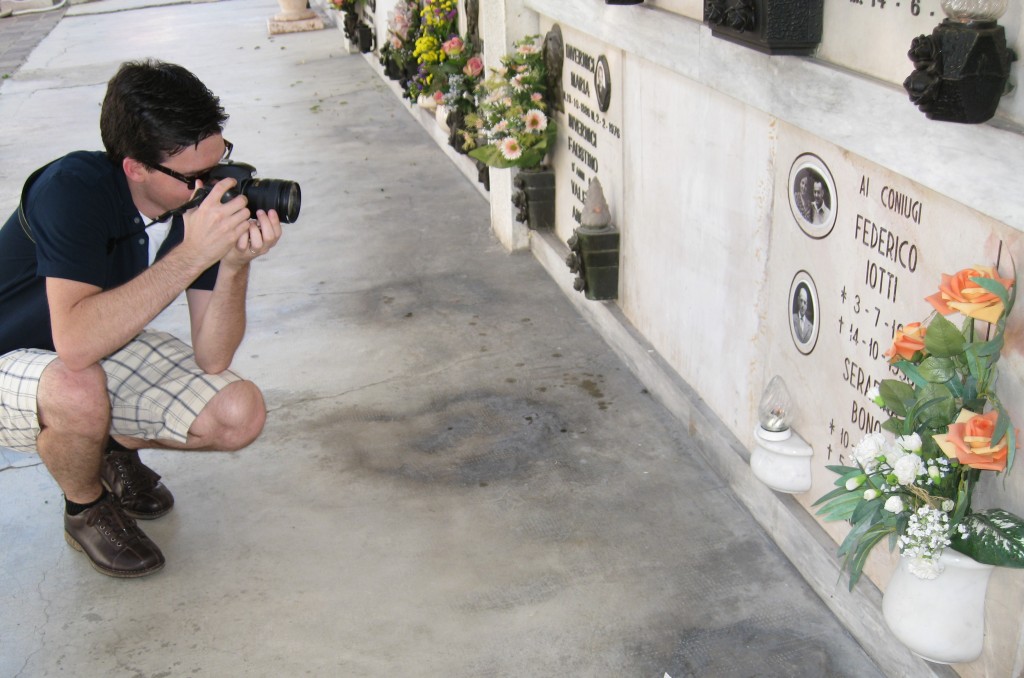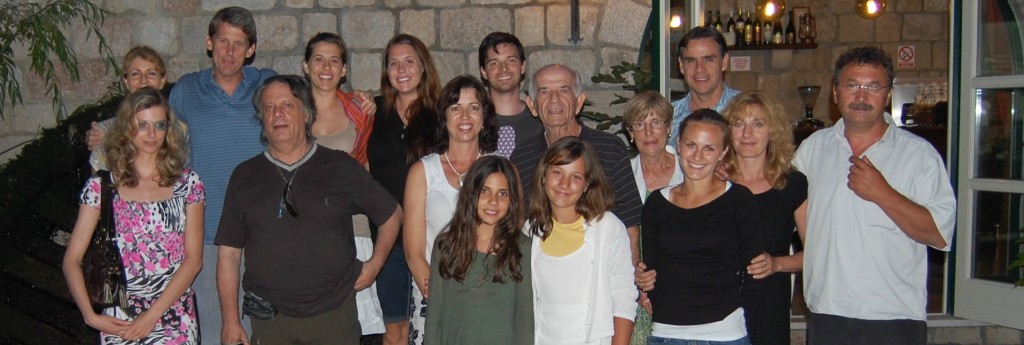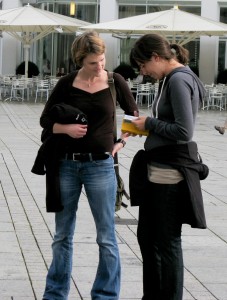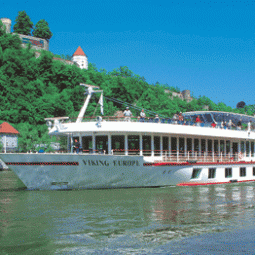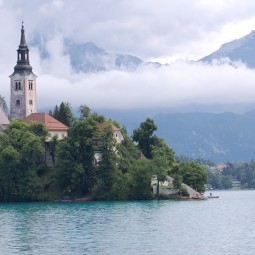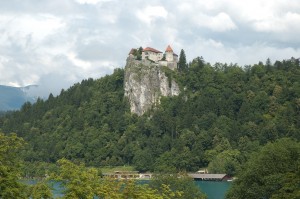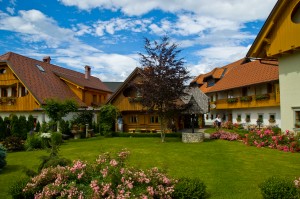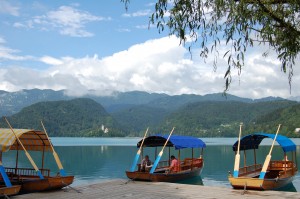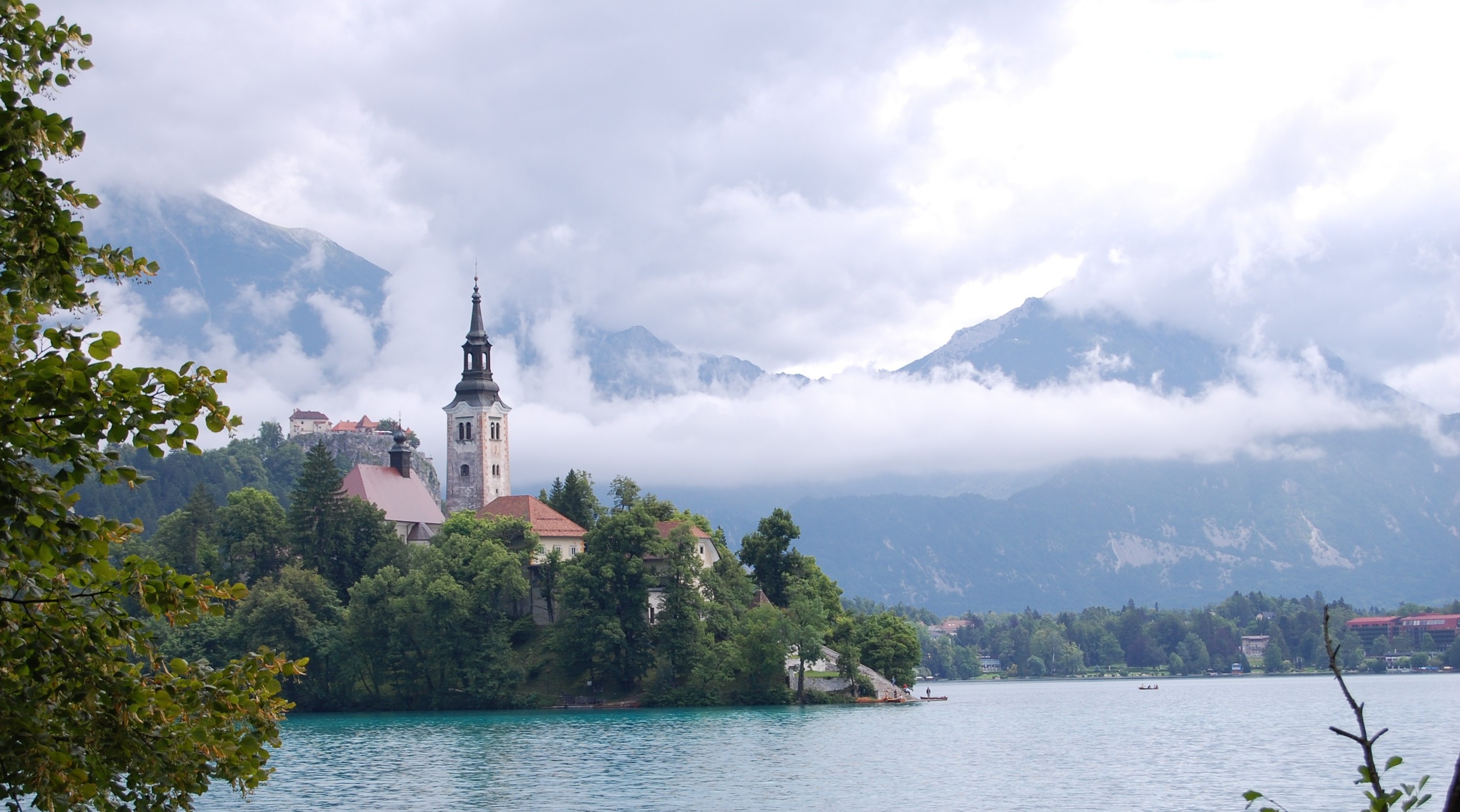 Our 2009 trip to Europe reminded us that we Californians have little concept of what old is. Mission San Juan Capistrano, Orange County’s oldest structure, has been around for less than 250 years. Buildings dating to the early 1900s earn vintage status. Seems laughable in Dubrovnik, Croatia, where the city’s walls have not only stood the test of time — 1,000 years worth — but survived Serbian shelling in the early 1990s. Munich (translation: of the monks) was settled by monks around the first milenium. Lake Bled’s hilltop castle dates back as far. Same with structures in Zadar, Croatia, which are built amid ruins dating back to the Roman Empire. In Dubrovnik, Franciscan pharmacists were pioneering Western medicine 750 years before members of their order founded the San Juan Mission.
Our 2009 trip to Europe reminded us that we Californians have little concept of what old is. Mission San Juan Capistrano, Orange County’s oldest structure, has been around for less than 250 years. Buildings dating to the early 1900s earn vintage status. Seems laughable in Dubrovnik, Croatia, where the city’s walls have not only stood the test of time — 1,000 years worth — but survived Serbian shelling in the early 1990s. Munich (translation: of the monks) was settled by monks around the first milenium. Lake Bled’s hilltop castle dates back as far. Same with structures in Zadar, Croatia, which are built amid ruins dating back to the Roman Empire. In Dubrovnik, Franciscan pharmacists were pioneering Western medicine 750 years before members of their order founded the San Juan Mission.
Our itinerary materialized through purpose and opportunism. The ultimate destination was Dubronik, where Susan’s father was arranging a gathering of his American family and Croatian relatives. We were able to cash in some Marriott Rewards points for a couple of round-trip flights and a week at the Munich Courtyard. So we rented a car and broke up the drive between with stays in Lake Bled, Slovenia, and Zadar.
MUNICH

This modern city mixes the old and the new–by necessity and design. It can be a bit confusing in Old Town, where Old Town Hall is newer than New Town Hall. That’s because the orginal Old Town Hall was destroyed in the World War II bombing. Fortunately, Munich’s postwar leaders decided to rebuild and restore the city’s historic core, rather than start from scratch as some other decimated German cities did. So you can stand in central Marienplatz surrounded by structures that recall Bavarian history, even though they may house a modern department store and a McDonald’s.
Two defining characteristics stand out quickly:
- Central Munich’s concentration of Catholic Churches seems to rival that of Rome. If you think of Germany as a Protestant country because Martin Luther nailed his 95 theses within its present confines, you haven’t been to Bavaria, which was an independent kingdom among many small Germanic states in Luther’s Day. Marienplatz, Munich’s central square, is named for the Virgin Mary, a statue of whom rises from its center. Bavaria is also the birthplace of Pope Benedict, who is said to enjoy Italian shoes and German beer.
- Bavarians really like their beer. Beer halls and pubs are even more plentiful than churches. Being a conscientious reporter, I made a point to sample a variety of local brews, which I found to be of high quality and low cost. At restaurants, beer tended to be less expensive than bottled water and soft drinks. What a city!

Two tours of Old Town — one walking and one aboard bikes — provided orientation, historical background and laughs. Distinguishing the historical from the apocryphal was not always easy. Torture duirng the Swedish occupation involving Ikea furniture without allen wrenches was obviously a joke. Soberly delivered descriptions of Hitler’s rise to power and the part Munich sites played can be checked out with the historical record. But what about below-table gutters in the famous Hofbrau House that enabled patrons to relieve themselves without surrendering their strategic place at the table of the city’s power brokers? Totally plausible — with the ring of a punch line. The Radius Tours were free and entertaining, the guides depending on tips. The compnay offers other tours further afield.
We climbed to the top of the 12th Century St. Peter’s Church, built in the 12th century, for an overview of the city (The cloud cover obscured the promised view of the Alps). We learned some distinctions of the German and American legal systems, particulalry in terms of liability lawsuits. Helmets are not passed out on the bike tour. Police do not enforce the signed prohibition of getting into the Issar River, where inland “surfers” continu
ously ride an eddy. Our guide said homesick Californian soldiers strategically placed rocks in the bottom to create the effect that re-created a little bit of home. He also pointed out that police pay no heed to those who ignore the warning. Unlike American courts. the German justice system does not reward risk takers. Big liability lawsuits would not be options for river surfers speedy autobahn drivers. And they come up very fast on those speed-limitless highways.
Steady rain did not prevent us from enjoying all Munich has to offer. Equipped with hoods and umbrellas, we saw everything on our lists, except the nudists who usually fill a field in the English Garden, Munich’s Central Park. We were not such big fans of the heavy traditional food–pork, sausages and potatoes. Fortunately, our hotel had a good and reasonably priced Mediterranean restaurant and we found a good vegetarian place. I should mention that the Munich Courtyard not only took our Marriot Reward Points as payment, but was an ideal base from which to explore Munich — A short walk from Old Town and just two blocks from the train station, where we rented a car after two days of exploring the core on foot. Some Trip Advisor comments decried its “seedy” surroundings, but a few strip clubs and casinos disn’t bother us. We simply walked past them to enjoy a beautiful city center.
We ventured afield of Munich-proper to take in some surrounding sights:
- BMW Museum: The array of autos from inception to concept would probably thrill a true car enthusiast. For us, it seemed like a pricey so-so excursion, even if we drive one of the manufacturer’s excellent cars.
- Dachau: A very sober timeout from a celebratory vacation, but worth it. You can read volumes about the Holocaust, but standing in a cell and looking at the crematorium and its smoke-stained chimneys is chilling. Iran’s president should make a visit. We had seen in Munich the site of Hitler’s defeat in the Beer Hall Putsch, which set off a chain reaction: his imprsionment, during which he wrote “Mein Kampf” (My Struggle), the bible of the Nazi movement. A Munich site, we were told, was memorialized by discoloration marks where a Swastica was once placed. Bavarians had to salute or risk an SS beating or possibly a trip to Dachau. A line on the pavement shows the detour people who wanted to avoid both the “zieg heil” salute and the punishment for declining it.
- Andechs Monastery and brewery: Munich, Munchen in German, means “of the monks,” and brewing beer is an enterprise they have long pursued to keep their monasteries running. Europe tour specialist Rick Steves recommends Andects as as good as it gets. Set on a hillside in the pastoral Bavarian countryside, Andects features both a place for spiritual refection and for temporal sustenance. The beer, like all we tried in Bavaria, was excellent. Pretzels and pork filled out the menu. And the outdoor tables were filled with Germans, so you felt like you were in a true local hangout.
- Castles: My daughter Megan has raved about Neuschwanstein Castle since she visited during her semester abroad in 2005, so we knew we had to go to this site less than two hours from Munich. Neuschwanstein and sister castle Hohenscwangua handle Disney-style crowds with German precision (you need to reserve your tour time in advance). Neuschwanstein was built by Bavarian King Ludwig in the 1800s as a kind of idealized replica of Medieval castles and was inspiration for Walt Disney’s theme park castle. How fitting. The castles, set on the edge of the Alps, made for a great day trip.
AUSTRIA
We had planned to see Salzburg, Austria, on our way down to Lake Bled, Slovenia. But instead of the light rain we encountered in Munich, it was
pouring, making a walk a round town untenable. Fortunately, the Hallein Salt Mine is underground, so we were able to get a taste of Austria. Salt, we learned, was the source of wealth in the area because of its value in food preservation before refrigeration. You get to don white jumpsuits and ride a mini-train into the mine, and slide down wooden slides to explore the depths of the mine. It was funny that the literature proclaimed “3 slides.” We only saw two, but we were told we could ride the second one twice.
round town untenable. Fortunately, the Hallein Salt Mine is underground, so we were able to get a taste of Austria. Salt, we learned, was the source of wealth in the area because of its value in food preservation before refrigeration. You get to don white jumpsuits and ride a mini-train into the mine, and slide down wooden slides to explore the depths of the mine. It was funny that the literature proclaimed “3 slides.” We only saw two, but we were told we could ride the second one twice.
SLOVENIA
Susan, Michelle, and I met Megan and Bryan in Slovenia after they had visited Bryan’s distant relatives in northern Italy. See separate post on Lake Bled and Megan’s post onLjubljana.
CROATIA
We split up the 10 hours of driving time between Bled and our final destination, Dubrovnik, Croatia, with a stop in Zadar, Croatia. We stayed the night at the Hotel Laguna on the coast north of Zadar and visited the historic city with its Medevial walls and buildings and Roman ruins sitting amid vendor booths. This is where Megan insisted on taking a dip in the Adriatic Sea in her underwear.
While Zadar was a pleasan t introduction to Croatia (and better than the larger central city of Split), Dubrovnik was a true climax to the trip. Its 1,000-year-old walled city has stood the test of time (and Serbian shells in the 1990s, as the locals are happy to remind you). We were to meet with Susan’s father and his wife, her sistster’s family and some Croatian cousins. The five of us in my immediate family stayed in a three-bedroom apartment with a commanding view of Old Town, some 300 steps down, and the sea. It was booked through Rose of Dubrovnik, which offers a variety of such accommodations.
t introduction to Croatia (and better than the larger central city of Split), Dubrovnik was a true climax to the trip. Its 1,000-year-old walled city has stood the test of time (and Serbian shells in the 1990s, as the locals are happy to remind you). We were to meet with Susan’s father and his wife, her sistster’s family and some Croatian cousins. The five of us in my immediate family stayed in a three-bedroom apartment with a commanding view of Old Town, some 300 steps down, and the sea. It was booked through Rose of Dubrovnik, which offers a variety of such accommodations.
Simply put, Dubrovnik is an iconic European fortress city. The limestone streets have been worn smooth by 1,000 years of foot traffic and the elements. Its rock walls house tourist serving businesses and the West’s oldest pharmacy in the Franciscan monastery. We descended and climbed the steps between Old Town and our aprtment often. We bought Michelle a Croatian flag to go with a Bavarian one we acquired earlier so she could celebrate her heritage in her college apartment. We had a great meal at Proto, which food conisseuer and son-in-law Bryan found highly rated. We walked the promenade and side streets, discovering, among other things, several Irish pubs. A relative, Silva, manages a religous gift shop in Old Town and we ran into her dau ghter Doris on several occasions. She took our Megan, Michelle and Bryan out for a late night on the town.
ghter Doris on several occasions. She took our Megan, Michelle and Bryan out for a late night on the town.
We also enjoyed dips into the warm and calm Adriatic Sea — more like a calm lake than Orange County’s Pacific but with temperatures comparable to Hawaii. We hired a boat to take us out to the nearby island for a swim in a cave and a view of a nude beach. So we got to see what we missed in Munich — exposed white European bodies of various sizes and shapes. Our chain-smoking “captain” read the sports page at every chance. He said he was mostly interested in soccer, so he knew we had Beckham in L.A. He also knew that Lakers coach Phil Jackson is part Croatian. That’s good. Vlade Divacs is Serbian. Not so good.
A longer group trip on a bigger boat took us to three islands further afield, where we experienced tiny villages. An excursion to Cavtat, between Dubrovnik and the Montenegro border, gave us a taste of the elite life with large yachts parked along the boardwalk. Our last night was spent at a traditional restaurant in in the country with relatives from both sides of the Atlantic in honor of my father-in-law’s birthday. For Megan and Bryan’s take on Croatia, see Two Steps Far.
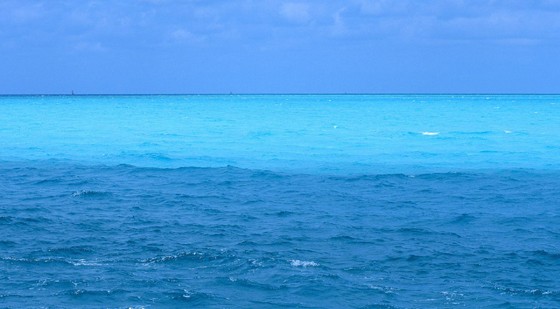

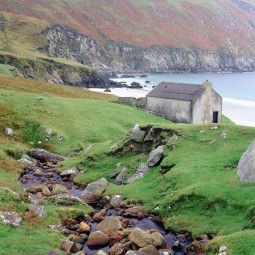

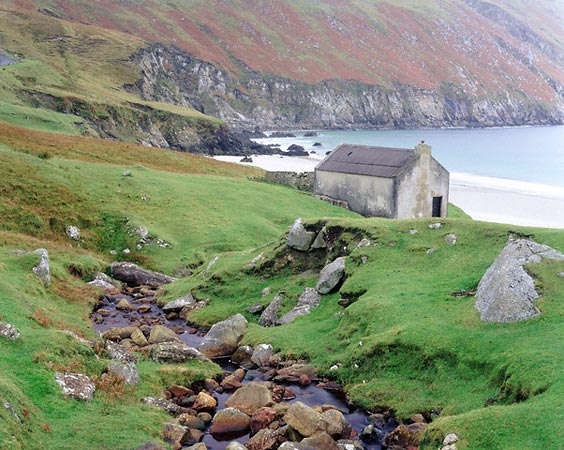 APPARITION, the BASILICA, and the FOLK MUSEUM. Maybe join the evening rosary processions. (Breakfast, Dinner)
APPARITION, the BASILICA, and the FOLK MUSEUM. Maybe join the evening rosary processions. (Breakfast, Dinner)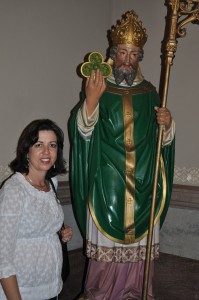
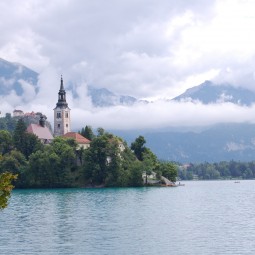





 round town untenable. Fortunately, the
round town untenable. Fortunately, the  t introduction to Croatia (and better than the larger central city of Split), Dubrovnik was a true climax to the trip. Its 1,000-year-old walled city has stood the test of time (and Serbian shells in the 1990s, as the locals are happy to remind you). We were to meet with Susan’s father and his wife, her sistster’s family and some Croatian cousins. The five of us in my immediate family stayed in a three-bedroom apartment with a commanding view of Old Town, some 300 steps down, and the sea. It was booked through
t introduction to Croatia (and better than the larger central city of Split), Dubrovnik was a true climax to the trip. Its 1,000-year-old walled city has stood the test of time (and Serbian shells in the 1990s, as the locals are happy to remind you). We were to meet with Susan’s father and his wife, her sistster’s family and some Croatian cousins. The five of us in my immediate family stayed in a three-bedroom apartment with a commanding view of Old Town, some 300 steps down, and the sea. It was booked through  ghter Doris on several occasions. She took our Megan, Michelle and Bryan out for a late night on the town.
ghter Doris on several occasions. She took our Megan, Michelle and Bryan out for a late night on the town.